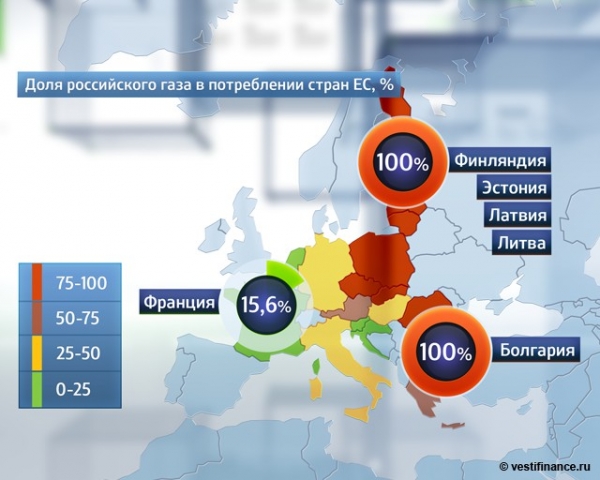Everyone knows that insatiable up to other people’s wealth and lands neighboring Russia is asleep and sees how to conquer and subjugate yourself to such small and defenceless, but this proud and freedom-loving Europe. And treacherous Russian nobles headed for Breakfast drinking the blood of babies brutal dictator Vladimir Putin is constantly coming up with new techniques and tools for the enslavement of Europe. And of course, every child knows that one of the most dangerous instruments of the conquest of Europe is Russian gas.
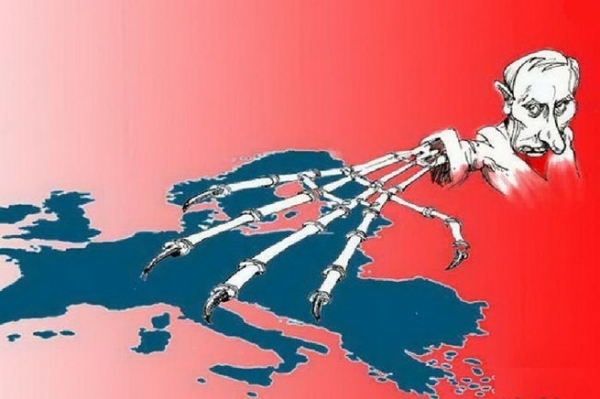
Gas filled tentacles “Gazprom” entangled on all sides Europe claws and poisonous gas dig into her defenseless body. At greatest risk are the core countries of the European Union: in recent years, the Russian gas exports to Germany grew by 42.1%, in Britain – to 170.2%, in Italy – 23.4%, in Poland – 58.1 per cent, to France – by 22.8%, to Austria – by 75.5%. And in the heart of Europe is already committed to reach out a new poisonous tentacle – gas pipeline “Nord stream-2”.
4 September 2015, Gazprom, BASF, E. ON, ENGIE, Shell and OMV signed the shareholders agreement on creation of gas pipeline system “Northern stream-2” capacity of 55 billion cubic meters of gas per year from Russia to Germany under the Baltic sea. The pipeline will run next to the “pipe” of the “North stream-1” similar to power leveling. The project is implemented by the project company Nord Stream AG, 2. After the closing of the transactions on acquisition by foreign shareholders of shares in Nord Stream AG 2 share in the project will be distributed as follows: Gazprom — 50%, BASF, ENGIE, OMV, Shell, Uniper (100% subsidiary of E. ON) — 10%. “Nord stream-2” will almost completely replace pumping gas through the gas transportation system of Ukraine under its current load (a little more than 60 billion cubic meters of gas per year).
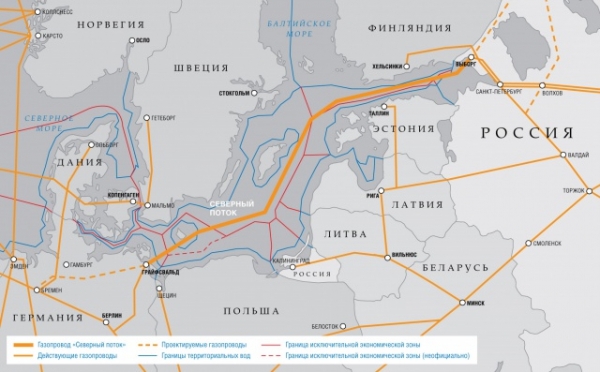
Construction of the pipeline will lead a consortium of major European energomascorporatsiya, in which “Gazprom” will belong 51%, E. ON, Shell, OMV and BASF/Wintershall – 10% each, ENGIE – 9%. The participants expressed full confidence that the gas pipeline “Nord stream-2” will necessarily be built. According to the plan this should occur before the end of 2019. The head of one of the members of the consortium, the Austrian oil and gas group OMV, Rainer Seele said recently that the project has a high level of profitability and economic feasibility and it will be invested about 10 billion euros.
Official support for the construction of the pipeline also have the authorities in Germany and several other countries of Northern and Central Europe who are interested in stable gas supplies to bypass Ukraine. This is, in particular, was discussed at a recent meeting of head “Gazprom” Alexey Miller and Vice-Chancellor of Austria Reinhold Mitterlehner. With the help of Russian gas to Austria intends to consolidate its leading position in the gas market of Central and South-Eastern Europe. The Alpine Republic is going to expand underground gas storage “Hyde” – the largest in Austria and second largest in Central Europe. In 2015, the parties agreed on the possibility of increasing the volume of “Haidach” 150 million cubic meters (5%).
Against the construction of the gas pipeline “Nord stream-2” are the European Commission, the USA, Ukraine, Hungary, Romania, Poland, Slovakia and the Baltic States.
The Directorate-General for energy of the European Commission insists that the EU Laws including the so-called Third energy package should be applied not only to the coastal parts of the “Nord stream-2”, but also to the marine component, which comes under the territorial jurisdiction of Finland, Sweden, Denmark and Germany. According to the requirements of the Third energy package, the company, which is engaged in the production of natural gas may not be the owner of the pipeline system, located on the territory of the European Union. Such a company must transfer control of the pipeline system the operator from the EU or sell the asset, while the participation of foreign persons in control of the operating companies special bureaucratic procedures are reduced to zero. Thus separating the sale and transportation of gas the European Commission is attempting to strengthen its control over the gas market.
At the same time the newspaper Politico citing a memo of the legal service of the European Commission informs:
“According to the findings of the legal service of the European Commission, mentioned in an internal memo, the rules of the energy market of the EU are not subject to the gas pipeline project “Northern stream-2″. This finding may undermine all attempts to block the project.”
Obviously, the withdrawal of the legal service of the European Commission is a serious blow on positions of the political opponents of the “Nord stream-2” in Washington and European capitals, “who argue that Moscow’s plans on the extension of gas pipeline to Germany are harmful to Ukraine”, – notes Politico.
Recently against the construction of a gas pipeline under the Baltic sea was made by States in southern Europe, particularly Italy. Their objection is due to the fact that in Germany, with the support of officials from the European Commission and U.S. officials opposed the construction of the gas pipeline “South stream” which should pass under the Black sea and then through Bulgaria, Serbia and Hungary to Austria and Italy. As a result of German pressure, the European Commission and the United States in Bulgaria the project “South stream” was implemented.
However, unexpectedly it turned out that “South stream”, which in the US and the EU prihidko many already celebrated, was surprisingly tenacious, and another poisonous claw “Gazprom” wants to pierce tender flesh of Europe from the South.
In late February the head of Gazprom, Italy’s Edison SpA and Greek company DEPA SA signed a “Memorandum of understanding regarding the supply of natural gas from Russia under the Black sea through third countries to Greece and from Greece to Italy”. As reported in a press-release of Gazprom, the purpose of the agreement is the organization of the southern supply route of Russian gas to Europe. The press release also notes that the agreement reflects the interest of the parties in the supply route of gas from Russia under the Black sea through third countries to Greece and from Greece to Italy. For this purpose the parties intend to use to the maximum extent the work done by Edison and DEPA in a project ITGI Poseidon (the gas pipeline project from Turkey Cerezyme Greece to Italy).
The Executive Director of the Italian Edison Benayoun Marc noted that a potential project of the new supply route will enhance the reliability of gas supplies to Italy, as well as strengthen its role as major gas hub in southern Europe.
The leadership of the Greek DEPA believes that the revival of ITGI Poseidon project enhances energy security of Europe thanks to the emergence of additional channels of delivery and increases the role of Greece as a major corridor for gas supplies from various sources and routes.
It is noteworthy that the signing of the agreement took place after the meeting of head “Gazprom” Alexey Miller with the Minister of economic development of Italy Federica Guidi, which was held in Rome. But the signing ceremony was also attended by the Secretary-General of the Ministry of foreign Affairs of Greece on international economic relations Giorgos Tsipras. This is a direct indication of support of the Memorandum by the governments of Italy and Greece.
Of course, then the question immediately arises: “Through which these “third countries” the signatories of the Memorandum intend to supply gas from Russia across the seabed of the Black country to Greece?”
Well, it’s certainly not through Turkey. I think there is little doubt that the “Turkish stream” long haul was killed in an unequal battle in the sky of Syria. But the “Bulgarian variant” starts to gain quite real features.
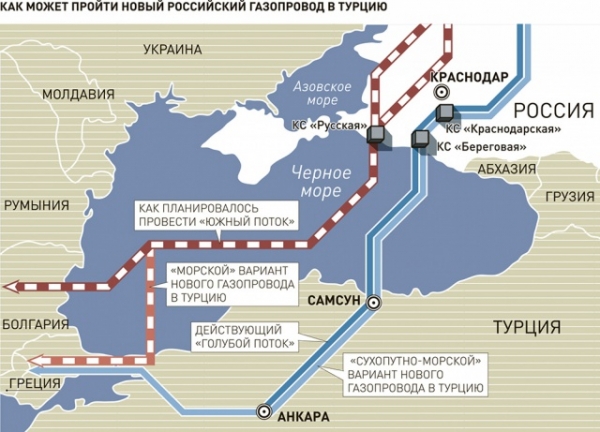
After the untimely death of the “Turkish stream,” the Prime Minister of Bulgaria Borisov began to actively promote the idea of the project, which is informally called “Bulgarian stream”, i.e. the revival of a part of the “South stream” the Russian gas terminal in Anapa on the Black sea coast to the Bulgarian coast of the Black sea. In particular, in an interview with the German edition of Deutsche Welle from January 5, 2016 Borisov spoke about the development of the hub with a capacity of at least 43 billion cubic meters of gas per year. In this case, Bulgaria would become a transit country for Russian gas supplies to Greece. Then the gas goes through the pipe long 787 km route of adapted gas pipeline project ITGI Poseidon via Greece to Italy. The final part of the pipeline with a length of 207 km will run along the bottom of the Adriatic sea from Thesprotia in Greece to Otranto in Italy.
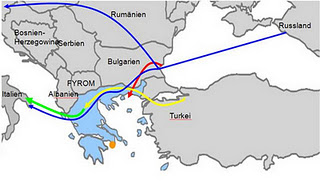
Bulgarian Prime Minister talked about the fact that the gas pipeline via Bulgaria will be pumped to gas not only from Russia but also from Azerbaijan and Turkmenistan, as well as new deposits in the Bulgarian and Romanian sector of the Black sea. However, in this list of something real is just gas from Russia and Azerbaijan, while the latter looks insignificant (until 2020 Azerbaijan needs to supply to Bulgaria of 1 billion cubic meters of gas a year from his field “Shah Deniz-2”, and deliveries are planned to be provided through under construction of Tanap gas pipeline). Turkmensky, and especially the Bulgarian and Romanian gas is still something very vague and almost illusory.
Taking into account the existence of the Third energy package, it should be noted that the construction of a new gas pipeline on Bulgarian territory will be carried out under the same conditions as the construction of the “Nord stream-2”. That is, the responsibility and costs of “Gazprom” will have to end at the edge of the Bulgarian Black sea coast. Next, the construction of the pipeline, unlike the “South stream”, will have to lead the countries of the European Union. And since the project will cost at least 5 billion euros, the question arises where the member countries will seek funds for its implementation. And concrete answer to this question is still no.
If the new version of the pipeline through the Balkans still be implemented, Gazprom will be able to expand gas supplies to Italy in bypass Ukraine and reduce the “Nord stream-2” with two branches to one. The main thing that the laying of the pipeline neutralizes the counter Italy “Nord stream-2” because this project provides the opportunity to deliver gas to southern Italy and to support the aspirations of Italy to become a major gas hub in Southern Europe.
But that “Gazprom” is not enough – another poisonous tentacle he stretched out in the center of Europe. “Gazprom” develops the third area of gas supplies to Europe via Belarus. Gazprom owns the Belarusian section of the gas pipeline “Yamal-Europe” length of 575,5 km and by 2020 plans to invest 2.5 billion. in the development of the gas transportation system, and $ 1.1 billion. – to increase capacities of underground gas storages on the territory of Belarus.
From all this the conclusion arises that the aggressive and expansionist plans of Russia extend very far…

